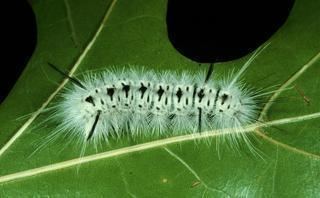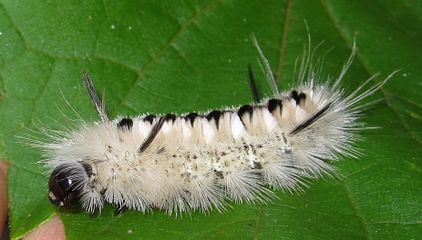Higher classification Lophocampa | Family Arctiidae Scientific name Lophocampa caryae Rank Species | |
Similar Lophocampa, Insect, Spiny oak slug, Saddleback caterpillar, Butterflies and moths | ||
Hickory tussock moth larva lophocampa caryae
Lophocampa caryae, the hickory tussock moth or hickory halisidota, is a moth in the family Arctiidae, widely distributed in the eastern half of North America. Like most species in its family, the caterpillars acquire chemical defenses from their host plants, so they are potentially toxic or unpalatable, but this species is also venomous. The behaviour and aposematic coloration of the larvae suggests chemical protection in this stage, although they have not been analyzed for alkaloid or cardenolide content, nor have the adults.
Contents
- Hickory tussock moth larva lophocampa caryae
- Lophocampa caryae larvae hickory tussock moth
- Life cycle
- Larva
- Pupa
- Adult
- References
Lophocampa caryae larvae hickory tussock moth
Life cycle
There is one generation per year.
Larva

The larva, a caterpillar, is completely covered in long, hairlike setae arranged in spreading tufts. Most are white, but there are black tufts along the middle of the back, and four long black hair pencils, two near the front, and two near the back. These hairs cause itchy rashes (contact dermatitis) in many people, particularly those prone to allergies, and may resemble exposure to urushiol. They are microscopically barbed and may cause serious medical complications if they are transferred from the hands to the eyes. There are black spots along the sides, and the head capsule is black.
The later-instar caterpillars are seen between July to October. They feed in groups of about 100 or so in the early instars, skeletonizing leaves. Older larvae are solitary. They grow up to 4.5 centimeters long before pupating.
Pupa
The cocoon is loose and has setae woven into it. It overwinters in the leaf litter.
Adult

The adult moth flies in May and June. The forewings are yellowish-brown marked with white splotches, reminiscent of stained glass. The hindwings are mostly white. The body is hairy and pale brown.
The moth primarily feeds on hickory, pecan and walnuts, but will also eat ash, elm, oak, willow, and other plants. It occasionally causes local defoliation of nut trees, but high densities do not last long enough to cause significant damage.
